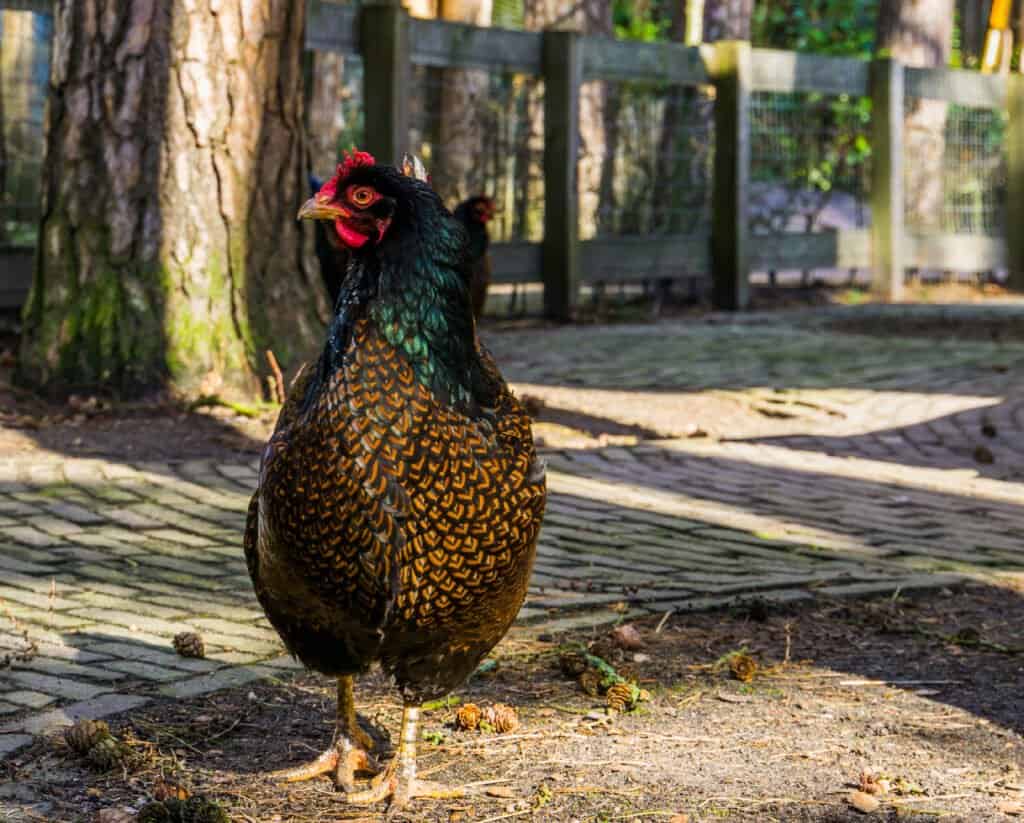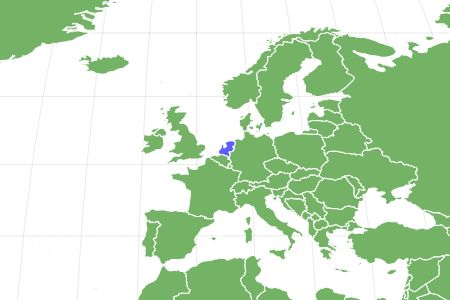Barnevelder
Gallus gallus domesticus
The average lifespan of a Barnevelder chicken is 7 years. However, if cared for properly, these chickens can live up to 15 years old.
Advertisement
Barnevelder Scientific Classification
- Kingdom
- Animalia
- Phylum
- Chordata
- Class
- Aves
- Order
- Galliformes
- Family
- Phasianidae
- Genus
- Gallus
- Scientific Name
- Gallus gallus domesticus
Read our Complete Guide to Classification of Animals.
Barnevelder Conservation Status
Barnevelder Facts
- Name Of Young
- Chicks
- Group Behavior
- Flock
- Fun Fact
- The average lifespan of a Barnevelder chicken is 7 years. However, if cared for properly, these chickens can live up to 15 years old.
- Distinctive Feature
- Arrowhead pattern on the hen's feathers
- Incubation Period
- 21 days
- Predators
- Fox, raccoon, weasel, fisher cat, opossum, and domestic dogs
- Diet
- Omnivore
- Lifestyle
- Diurnal
- Common Name
- Barnevelder
- Origin
- Netherlands
Barnevelder Physical Characteristics
- Color
- Red
- Black
- Light-Brown
- Skin Type
- Feathers
- Lifespan
- 7-15 years
- Weight
- 5-8 pounds
- Aggression
- Low
View all of the Barnevelder images!
Barnevelder chickens originate from the Barneveld region in the Netherlands, where it is immensely popular and often the first breed natives think of when the word chicken is mentioned. They are highly sought-after for their dark brown eggs. While these birds are aesthetically pleasing, they are also hardy and adapt well to being confined. Barnevelders are medium to large-sized, dual-purpose chickens that produce a good number of eggs, and while they are not the biggest, their carcass yields a reasonable amount of meat.
Barnevelder History
While these chickens are a relatively recent breed, their genetic makeup is a bit of a mystery. It all started in Barneveld, which is a region in the Netherlands home to a large agricultural college that specializes in poultry. Therefore, it became a hub for the poultry industry in the early 20th century. The egg supply market was huge, and farmers in the area supplied eggs to the whole of Europe. However, British natives wanted brown eggs, so farmers had to find a breed to keep up with the demand. Initially, farmers raised landrace chickens and other local breeds that had been around forever. However, with the introduction of Oriental chickens, the farmers started to crossbreed their hens with Asian birds.
Breeds used included Malays, Brahmas, and Langshans, but in 1898, farmers decided to add Laced Wyandottes to the list of suitable mates. As a result, there are a lot of variations to Barnevelder lines. Unfortunately, this meant that different people had different opinions of which hybrid resulted in the true Barnevelder breed. Therefore, the Barnevelder Breeders Association was formed to bring conformity to the breed, and it was finally standardized in 1923.
Barnevelder Amazing Facts
- Barnevelders are one of the most aesthetically pleasing chickens in the world. Their feathers have a unique pattern; they are brown with a double black border, which makes them look like arrowheads.
- The average lifespan of a Barnevelder chicken is 7 years. However, if cared for properly, these chickens can live up to 15 years old.
- Barnevelders are great at laying eggs. In fact, they can produce three to four eggs weekly, typically amounting to 150 to 200 eggs annually.
Barnevelder Scientific Name
The Barnevelder’s scientific name is Gallus gallus domesticus, and they belong to the order Galliformes, which consists of over 250 species and five families. Members of this order have chicken-like bodies and vary in size from small to large. Additionally, they have rounded wings, small round heads, small bills, and plump pear-shaped bodies. Some species have wattles on their necks, like the turkey. These birds are found all over the globe except for Antarctica and can adapt to various habitats like grasslands, forests, and deserts.
Barnevelders are members of the Phasianidae family, which is made up of 181 species. Many members of this family are ground-dwelling birds that eat plant matter, insects, and seeds. Additionally, most females belonging to Phasianidae lay a lot of eggs in nests on the ground. Chicks can feed themselves shortly after hatching, which is known as precocial.
Barnevelder Size, Appearance & Behavior

Barnevelder hens have unique arrowhead patterns on their feathers.
©Charlotte Bleijenberg/Shutterstock.com
Barnevelders are one of the most aesthetically pleasing chickens in the world. Their feathers have a unique pattern; they are brown with a double black border, which makes them look like arrowheads. It’s actually such a simple pattern, yet incredibly stunning. Additionally, the neck feathers are totally black with no pattern. Achieving this genetic effect is pretty complex, and hens are the only ones with this pattern. Roosters look completely different with their black–breasted, reddish color. While many breeders have tried replicating the arrowhead pattern in roosters, it has never been achieved.
These chickens have a rectangular, compact body shape with a U-shaped back. Due to their wings sitting so high on their bodies, they aren’t good flyers. In addition, their necks are slightly arched, and they have perky tails that stand at 50 degrees with a slight feather spread. They have single combs with five points, red earlobes, and wattles. Furthermore, they have red eyes and a horned beak. Lastly, Barnevelders have yellow skin and legs, with four toes per foot. These chickens are medium to large birds, with hens weighing between 5 to 6 pounds and rooster weights ranging from 7 to 8 pounds.
Behavior
These chickens are very easygoing and rarely fight with each other or other breeds of chicken. Surprisingly, even the roosters are docile. They can become quite tame and will generally greet you with some low-key chattiness. In fact, they are pretty talkative but won’t be a nuisance because their voices are low and soft, which is nothing compared to Rhode Island reds which are extremely loud.
Barneys, as they of fondly referred to, are active birds. These birds love being able to free-range and are very good at it, but they also do well in confinement.
Barnevelder Diet
Barnevelder chicks need a high-protein diet; therefore, they need feed with 20%-24% protein content for the first eight weeks of their lives. Once they reach eight weeks, you can start to decrease the protein percentage to 16%. However, there are exceptions; for example, chickens who are stressed or molting require at least 20% protein in their feed, which boosts their metabolisms. Furthermore, hens require extra calcium to produce high-quality eggs with thicker shells. Therefore, owners need to add oyster shells to their diets.
Additionally, insoluble grit is vital to their diets as it helps them with digestion. Owners can feed this separately from their regular feed, but if these chickens are left to free range, they won’t require as much insoluble grit. In fact, foraging is the best way to get additional nutrients into chickens. So, it is beneficial to give them free rein during the day, in addition, to offering them feed. Lastly, ensure that these chickens always have access to clean water.
Barnevelder Predators and Threats
While Barbevelders are generally predator-savvy, they are not good flyers and can be an easy target for:
However, most of these predators are nocturnal, so having a secure coop is essential.
There are no significant threats to these chickens. While they were once considered a rare breed, they have recently gained popularity in countries with people searching for dark brown eggs.
Barnevelder Reproduction, Eggs, and Lifespan
The Barnevelder needs very little interference when it comes to breeding. All owners have to do is add a rooster to their flock of hens, and they will do the rest. Once hens and roosters mate, fertilized eggs will start to appear in the coop. If you don’t plan on breeding these chickens and only want them for egg production, don’t introduce a rooster to your hens.
Eggs
Barnevelders are great at laying eggs. In fact, they can produce three to four eggs weekly, typically amounting to 150 to 200 eggs annually. Their eggs are chocolate brown in color, but some can appear lighter. In addition, these chickens lay eggs in the winter, which is quite rare as most chicken breeds slow or stop production when the weather gets colder. This makes them ideal for people looking to raise them for the purpose of selling eggs.
Lifespan
The average lifespan of a Barnevelder chicken is 7 years. However, if cared for properly, these chickens can live up to 15 years old.
Barnevelder Population
While the Barnevelder isn’t the most popular chicken breed in the world, they aren’t that rare. There is no conclusive data on their population size, but they seem to be growing in popularity, especially in the USA. When trying to locate this breed, check with local and foreign hatcheries, as many ship these birds all over the world. In addition, it’s important to use reputable breeders when purchasing Barnevelders to ensure the health of your flock.
Up Next
View all 285 animals that start with BBarnevelder FAQs (Frequently Asked Questions)
Are Barnevelder chickens good layers?
Barnevelders are great at laying eggs. In fact, they can produce three to four eggs weekly, typically amounting to 150 to 200 eggs annually.
What size eggs do Barnevelder chickens lay?
The Barnevelder lays large eggs that are 2.5 inches long and 1.7 inches wide and at least 2.2 ounces in weight.
What color eggs do Barnevelders lay?
Their eggs are chocolate brown in color, but some can appear lighter.
Thank you for reading! Have some feedback for us? Contact the AZ Animals editorial team.
Sources
- The Happy Chicken Coop, Available here: https://www.thehappychickencoop.com/barnevelder-chicken/
- Chickens and More, Available here: https://www.chickensandmore.com/barnevelder/
- Backyard Chicken Coop, Available here: https://www.backyardchickencoops.com.au/blogs/learning-centre/breed-profile-barnevelder

















